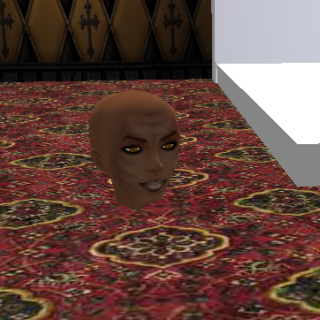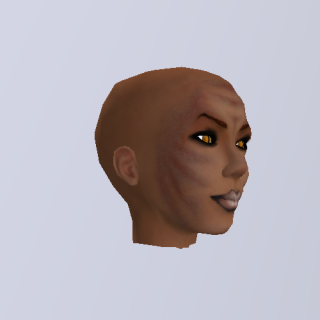Right now, Roxxxy doesn't move--not even to move her lips. I get the feeling, though, he's hoping to improve her. Right now, as she stands, he's got the Japanese sex-doll industry beat--because, while a few of them can speak pre-programmed phrases, Roxxxy can apparently learn new ones. She comes with a laptop and full drive equipped in her back, and can thus be programmed with choice phrases and personal details, but more than that, her software allows her to combine words into new concepts, and learn from those who interact with her.
Doctor Obolensky has been seen in airports! Well, at least one airport. Well, at least one comic about an airport.
When did he leave Babbage?!? That's all I want to know.
From the Electronic Freedom Foundation's Fair Use FAQ, some concise and pointed limitations of copyright law:
1. What is Fair Use?
In essence, fair use is a limitation on the exclusive rights of copyright holders. The Copyright Act gives copyright holders the exclusive right to reproduce works for a limited time period. Fair use is a limitation on this right. A use which is considered "fair" does not infringe copyright, even if it involves one of the exclusive rights of copyright holders. Fair use allows consumers to make a copy of part or all of a copyrighted work, even where the copyright holder has not given permission or objects to your use of the work.
Note: this does mean parody or satire, for the most part, and does depend on the impact of the original work. Satirizing the third leaf on the second tree in Wim Wender's first full-length film wouldn't necessarily work, because that's not as well known; but how many parody pieces have we all seen concerning the Mona Lisa or the Beatles?
2. How does Fair Use fit with Copyright Law?
Copyright law embodies a bargain: Congress gave copyright holders a set of six exclusive rights for a limited time period, and gave to the public all remaining rights in creative works. The goals of the bargain are to give copyright holders an economic incentive to create works that ultimately benefit society as a whole, and by doing so, to promote the progress of science and learning in society. Congress never intended Copyright law to give copyright holders complete control of their works. The bargain also ensures that created works move into "the public domain" and are available for unlimited use by the public when the time period finishes. In addition, as part of the public's side of this bargain, U.S. Copyright law recognizes the doctrine of "fair use" as a limitation on copyright holders' exclusive right of reproduction of their works during the initial protected time period.
The public's right to make fair use of copyrighted works is a long-established and integral part of US copyright law. Courts have used fair use as the means of balancing the competing principles underlying copyright law since 1841. Fair use also reconciles a tension that would otherwise exist between copyright law and the First Amendment's guarantee of freedom of expression. The Supreme Court has described fair use as "the guarantee of breathing space for new expression within the confines of Copyright law".
Now, I want to point out a few things I found extremely relevant in the upper paragraphs:
* Copyright law embodies a bargain: Congress gave copyright holders a set of six exclusive rights for a limited time period, and gave to the public all remaining rights in creative works.
* Congress never intended Copyright law to give copyright holders complete control of their works.
Let that sink in. Congress never intended--at least where US copyright law is concerned--to give copyright holders complete unassailable permanent rights to their creations. And they never intended to prevent any alternative use of copyrighted items--as long as that use falls under free speech, satire, or parody.
3. How Do You Know If It's Fair Use?
There are no clear-cut rules for deciding what's fair use and there are no "automatic" classes of fair uses. Fair use is decided by a judge, on a case by case basis, after balancing the four factors listed in section 107 of the Copyright statute. The factors to be considered include:
1. The purpose and character of the use, including whether such use is of a commercial nature or is for nonprofit educational purposes--Courts are more likely to find fair use where the use is for noncommercial purposes.
2. The nature of the copyrighted work--A particular use is more likely to be fair where the copied work is factual rather than creative.
3. The amount and substantiality of the portion used in relation to the copyrighted work as a whole--A court will balance this factor toward a finding of fair use where the amount taken is small or insignificant in proportion to the overall work.
4. The effect of the use upon the potential market for or value of the copyrighted work--If the court finds the newly created work is not a substitute product for the copyrighted work, it will be more likely to weigh this factor in favor of fair use.
Which are four very good principles, and I have mentioned these four before, for those of you suddenly thinking you'd read this prior on the 'Wreck.
4. What's been recognized as fair use?
Courts have previously found that a use was fair where the use of the copyrighted work was socially beneficial. In particular, U.S. courts have recognized the following fair uses: criticism, comment, news reporting, teaching, scholarship, research and parodies.
In addition, in 1984 the Supreme Court held that time-shifting (for example, private, non-commercial home taping of television programs with a VCR to permit later viewing) is fair use. (Sony Corporation of America v. Universal City Studios, 464 U.S. 417 (1984, S.C.)
Although the legal basis is not completely settled, many lawyers believe that the following (and many other uses) are also fair uses:
* Space-shifting or format-shifting - that is, taking content you own in one format and putting it into another format, for personal, non-commercial use. For instance, "ripping" an audio CD (that is, making an MP3-format version of an audio CD that you already own) is considered fair use by many lawyers, based on the 1984 Betamax decision and the 1999 Rio MP3 player decision (RIAA v. Diamond Multimedia, 180 F. 3d 1072, 1079, 9th Circ. 1999.)
* Making a personal back-up copy of content you own - for instance, burning a copy of an audio CD you own.
Which means that--for personal use and distribution between devices you also own--copying and transferring of music and media would also constitute fair use.
Though it's far more vague, at least where legal issues are concerned, to upload songs for "review purposes" that those uploading do not have full rights to use. However, in most cases, uploading music you do not own, with a stipulation that it's for review purposes only, paired with how to get the music legally, seems to be enough to satisfy most people.
In the meantime, new bug on the grid!

This one's deeply odd. If you can't quite make out what the glitch is, I moved over to my photo stand:

Normally, I don't Detach All, followed by removing all clothing layers, before I change outfits, but I was in a rush. Once I did, only my head remained! And every time thereafter I changed a system layer, I disappeared again!
Made it hell for getting dressed; changing skins; wearing eyes; and finding hair. Yaaagh.
For anyone who's curious: this was on the 'official' Linden Labs viewer, Snowglobe; the Snowglobe 1.3.0 (3085) Jan 8 2010 21:22:29 (Snowglobe Test Build) build, to be specific.

5 comments:
That's not Doctor O - that's the magician from Frosty the Snowman!
Diabolical!
Good work on Fair Use. Thats the key to artistic freedom. The case by case basis has a lot of precedent law deciding for those who can excerpt, or quote -
the original work and bring out some kind of heuristic about it.
Unfortunately, the "One standard for most" mentality of Linden Labs means they want standardized applications. Which may or may not be working out.
Someone named "Anastacia" (that I am not bothering to link) said this:
thanks for the information on this blog! I find it very interesting and entertaining! hopefully soon have updates that I love your post! I thank you too!
then followed that with three advertisements for Viagra.
She got her comment banned, but I found it so odd she'd say she liked the blog, then turned it into an ad campaign.
Very stupid, Anastacia.
Post a Comment